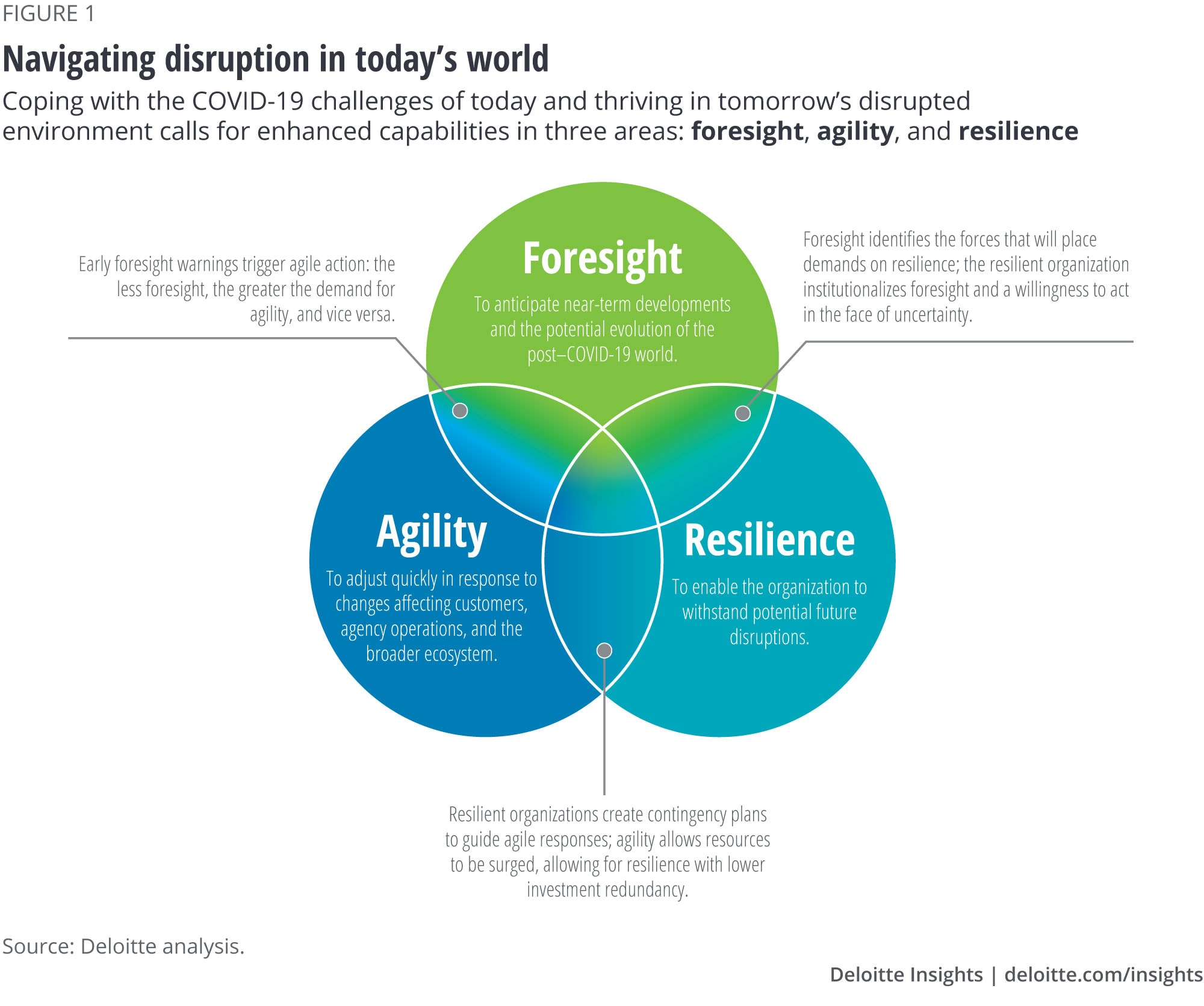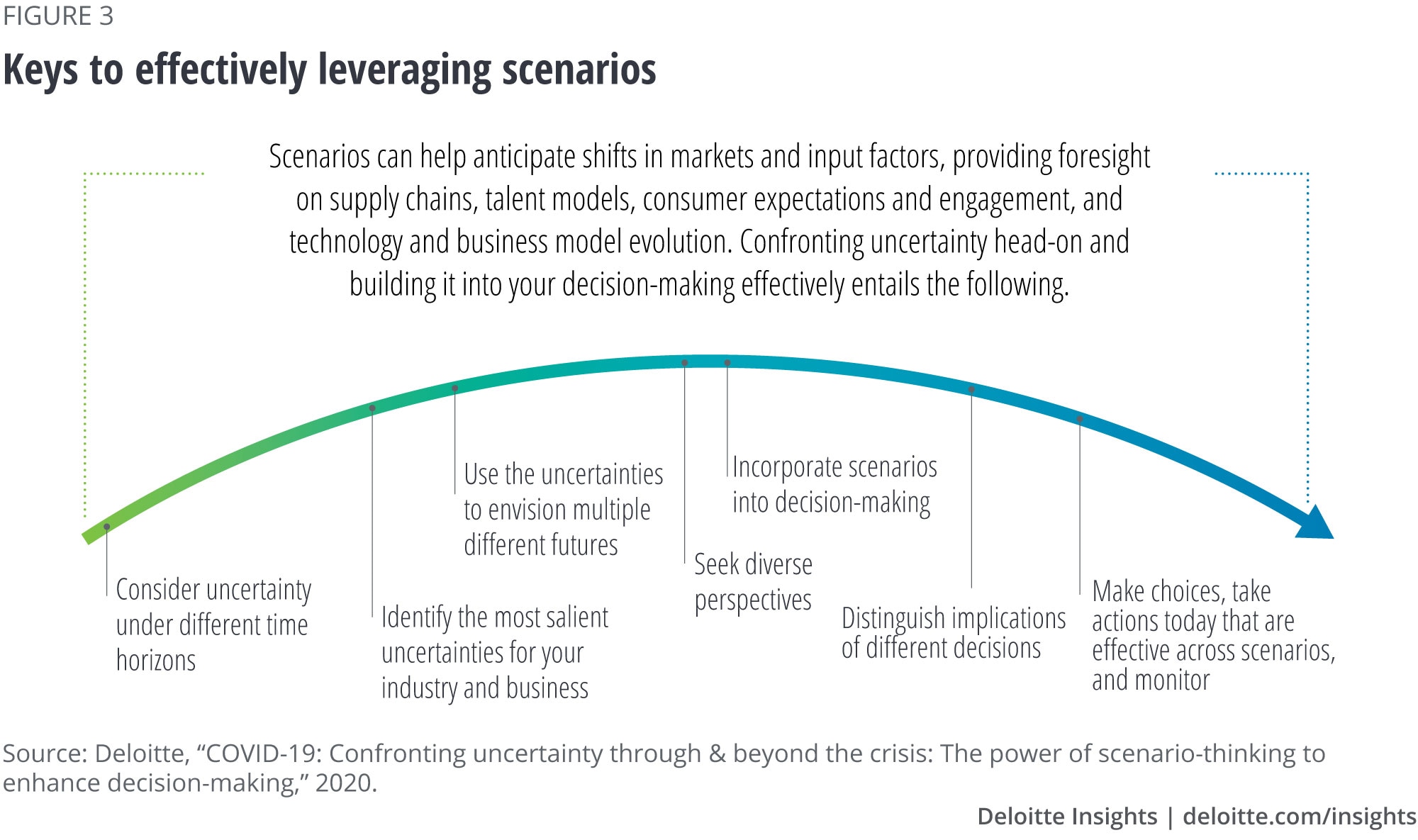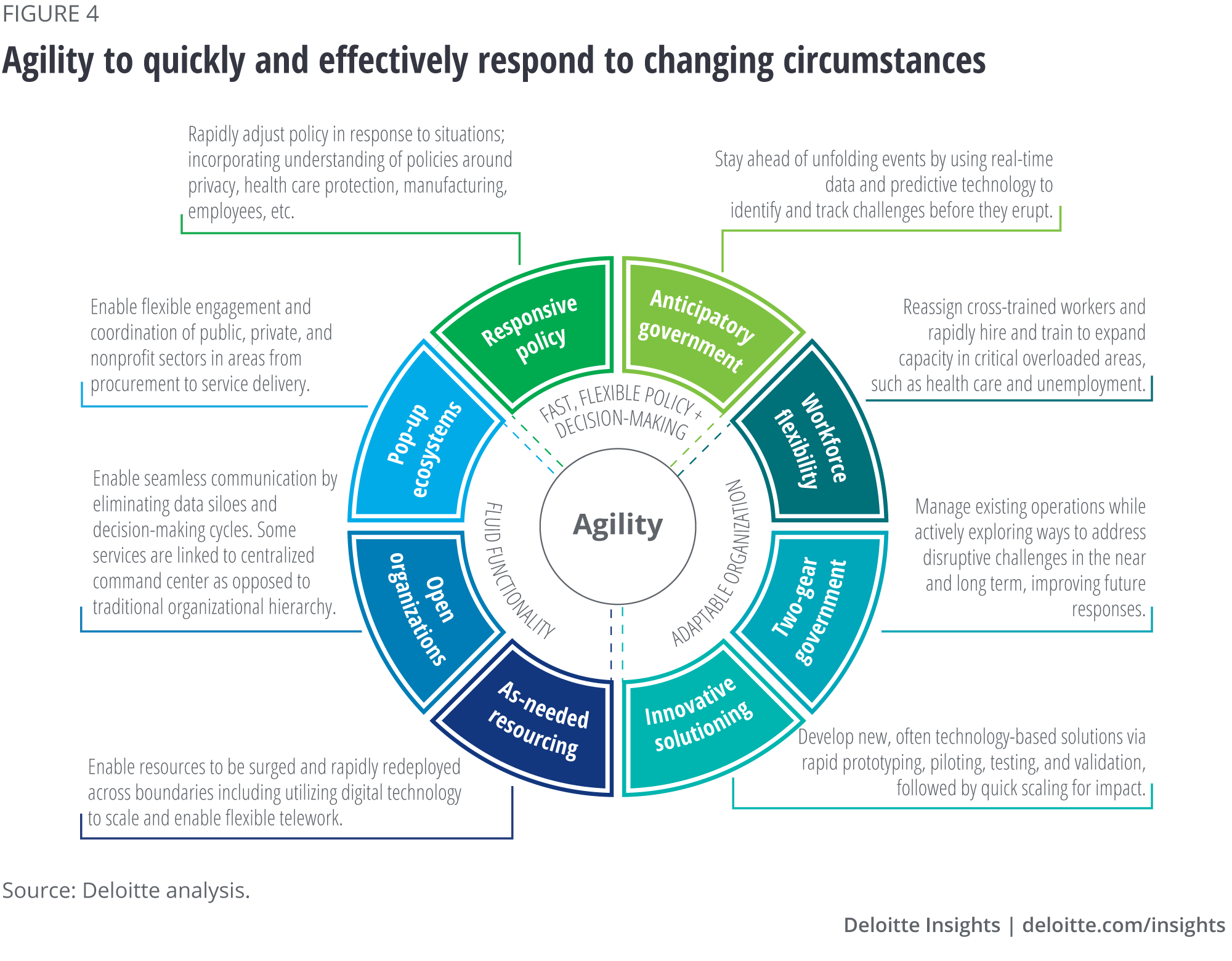
How governments can navigate a disrupted world Foresight, agility, and resilience
22 minute read
24 July 2020
 William D. Eggers United States
William D. Eggers United States Bruce Chew United States
Bruce Chew United States Amrita Datar Canada
Amrita Datar Canada Daryl Sng United States
Daryl Sng United States
Coping with today’s COVID-19 challenges and thriving in tomorrow’s disruptive environment calls for enhanced capabilities in three areas: foresight, agility, and resilience.
Introduction
The COVID-19 pandemic is just the latest in a growing list of disrupters confronting government. Tech disrupters such as the internet, social media, and artificial intelligence (AI) are dramatically transforming society. From cyberthreats and terrorist attacks to hurricanes and riots, disrupters abound. Massive societal change and demographic shifts, likewise, demand adaptation by government.
While future events may not take the same shape as the pandemic, they will require governments to navigate profound disruptions nimbly and effectively.
Learn more
Learn more about connecting for a resilient world
Download a summary slide presentation
Explore the Government & public services collection
Learn about Deloitte's services
Go straight to smart. Get the Deloitte Insights app
Governments will need enhanced capabilities in three areas to help navigate both current uncertainties and tomorrow’s more uncertain world:
- Foresight. Identifying forces and events that could place unprecedented demands on governments and their mission but could also create new opportunities for governments.
- Agility. Adjusting quickly to changes affecting customers, operations, and the broader ecosystem.
- Resilience. Withstanding and recovering from disruptions.
Consider this metaphor: If your organization is a ship navigating dangerous waters, then foresight is your ability to anticipate changes in sea and weather, scanning the horizon for immediate threats and anticipating more distant hazards to be able to act in uncertainty. Agility is how quickly and effectively you can steer your ship to respond and adapt to unexpected conditions. Resilience is the ability of your ship and crew to withstand distress and disruption.
Sometimes, elements of all three abilities are lumped together as “strategic foresight,” “future proofing,” or increasingly during the pandemic, “resilience.” This can be a useful conversational shorthand, but it’s worth the effort to examine each ability separately to understand their distinctive qualities and how they fit together.
While future events may not take the same shape as the pandemic, they will require governments to navigate profound disruptions nimbly and effectively.

Sometimes, elements of all three abilities are lumped together as “strategic foresight,” “future proofing,” or increasingly during the pandemic, “resilience.” This can be a useful conversational shorthand, but it’s worth the effort to examine each ability separately to understand their distinctive qualities and how they fit together.
Foresight
The pandemic has highlighted the importance of foresight. Of course, foresight has been a hallmark of some agencies, particularly those tasked with fighting adversaries or responding to disasters. The United States Coast Guard has used future alternative scenario planning, currently called Project Evergreen, for more than two decades.1 The US intelligence community has its Long-Range Analysis Unit; the Canadian Network for Defence and Security Analysis uses foresight and future scenario forecasting to advance defense capabilities.2 But recent events suggest the ability to anticipate disruption often brings significant value to all levels of government. While current events have brought attention to the downside of disruptive change, effective foresight can also be used to identify and embrace opportunities. Government looking ahead to the potential benefits of a disruptive technology such as AI is an example of foresight, focused on opportunity rather than risk.
Foresight abilities generally focus on two themes—understanding trends and uncertainties and analyzing scenarios.
Figure 2 lays out an approach to foresight planning, and how an organization could build a bias toward action in the face of uncertainty.

While most government agencies should have some foresight capabilities, it doesn’t necessarily require a separate foresight unit. Organizations can build these abilities through numerous avenues, engaging with academia, business, and others to understand risks and their implications. Budget and policy offices, government innovation offices, and other entities can come together to engage in strategic foresight exercises. The idea is to embrace uncertainty while actively taking steps to anticipate it.
Understanding trends
Horizon scanning, monitoring, and trends discovery
Not all unpleasant surprises result from sudden events. Social behavior, technology, and businesses are constantly evolving and can catch governments by surprise. Without the ability to sense emerging trends, government leaders and regulators risk finding themselves perpetually trying to catch up with changing citizen expectations, new business models, and innovative technologies. Sensing and horizon-scanning capabilities can help them stay ahead of the game.
For example, to understand the longer-term impact of technology on government policies, the Joint Research Centre of the European Commission has launched a research program that attempts to anticipate the implications of advanced technologies.3 The commission also has established the EU Policy Lab, a collaborative and experimental space that combines foresight exercises with behavioral science and design thinking to improve policymaking.4 In February, the group conducted a two-day workshop using foresight methods to envision the future of customs in the European Union in 2040, the results of which are being used to drive the political process of bringing customs to the next level.5
The United Kingdom Cabinet Secretary’s Advisory Group established a horizon-scanning program to better understand how possible future scenarios could affect policies set by the United Kingdom Civil Service. The program evaluates emerging technologies, resource supply and demand, changing societal attitudes, and demographic trends to understand how emerging trends may affect policymaking.6
Abilities such as these can help government executives better anticipate future risks and developments, allowing them to think about what new policies may be needed. Today’s technologies can help by synthesizing large amounts of data to unearth important trends. Machine and deep learning techniques can yield valuable insights, especially in moments of significant disruption when the cascade of new information can be overwhelming to decision-makers.
For example, the US government’s COVID-19 Open Research Dataset is the world’s most extensive collection of machine-readable coronavirus literature. The government is working with the tech sector to build AI tools that can help unearth important trends around COVID-19.7 This is just one example of how government can leverage data analytics and AI tools from a variety of sources, including the private sector, to track trends, identify events at the earliest stage, and anticipate later effects.
There’s also a need to understand the critical issues facing each agency, to inform data collection, trends analysis, and decision-making. The organization should avoid drawing its focus too narrowly, instead incorporating second- and third-order impacts as well as the full range of ecosystem participants. The government of Queensland and Australia’s Data61 of the Commonwealth Scientific and Industrial Research Organisation jointly run a “Q-Foresight” program that examines long-term trends and risks pertinent to the state in areas ranging from health to science and environmental policy.8 After the SARS epidemic, Asian nations like Singapore, Taiwan, and South Korea put in place robust epidemic tracking and containment systems. These were an asset while dealing with COVID-19.9
Foresight in action
- Singapore began its futures planning work in the late 1980s, initially for defense operations, and in the 1990s and 2000s created offices and programs focused on scenario analysis and horizon scanning. These efforts culminated in the 2009 establishment of the Center for Strategic Futures (CSF), a futures “think tank” that pursues open-ended, long-term futures research and experiments with new foresight methodologies. In addition to educating government stakeholders on its approach, CSF also facilitates sandbox events and quarterly meetings to discuss trends and implications.10
- Finland began its foresight journey in 1966 with the Sitra innovation fund, aimed at studying future development scenarios. In 1993, its parliament established the “Committee for the Future” to advance long-term, future-oriented thinking. In 2015, Finland launched a Government Foresight Group to coordinate foresight activities among different groups such as public agencies, think tanks, and universities and use them to inform decision-making. The prime minister’s office integrates all foresight activities and publishes a Government Report on the Future once per term, examining key issues for the nation during the next 10 to 20 years.11
Scenario analysis
Strategy, tracking, and planning
Even if one attempts to understand ongoing trends, high impact “black swan” events such as the pandemic can always occur. Scenarios address such uncertainty not by predicting the future but by considering a range of possible futures. They help in perceiving risks and opportunities more broadly and developing strategies that could be used across multiple scenarios.
Traditionally, scenarios are associated with longer-term futures and truly disruptive black swan events. But near-term scenarios also can be useful in times of great uncertainty. This can be seen in how scenarios are aiding governments as they move toward a post-COVID-19 world.
In the United States, the U.S. Department of Health & Human Services’ Centers for Disease Control and Prevention (CDC) and Office of the Assistant Secretary for Preparedness and Response developed five pandemic planning scenarios to inform decisions. The data outlined in these scenarios is being used to assess the potential effects of different community strategies, such as social distancing, and by hospital administrators to assess and plan for resource needs.12
Scenario planning, strategy, and tracking can help governments address uncertainty and disruption in the near and long terms (Figure 3: Keys to effectively leveraging scenarios).

The specific form of scenario work will vary depending on factors such as levels of formality, openness, and time horizon.
Classic scenario planning and strategy often focuses on the longer term—five to 10 years in the future and beyond—crafting multiple futures against which various actions can be developed and tested. One can imagine several different paths the world may take as a result of COVID-19 and use these possible near-term futures or broader longer-term futures as a backdrop to consider the implications for any government agency.
War gaming tends to focus on action and reaction across several “moves.” While it is common in national security and disaster exercises, it can be valuable even for organizations that don’t view themselves as “warriors” in the traditional sense. In the virtual game Urban Outbreak 2019, the U.S. Naval War College war-gamed a multinational humanitarian response to an infectious outbreak in a developing nation. They found that divergent institutional prerogatives and a scarcity of information often led to competing responses.13
Tabletop exercises provide a relatively structured approach to explore particular courses of action, often over a short time horizon, with dynamic risks introduced during the exercise. The current pandemic has spurred considerable government interest in tabletop exercises. In April 2020, for instance, Taiwan’s New Taipei City conducted an hourlong tabletop exercise to simulate government responses to a second wave of infections, detailing measures such as travel restrictions, business closures, and policies to ensure adequate supplies of essentials.14 The World Health Organization (WHO) has developed various COVID-19 tabletop exercise packages to address different aspects of the pandemic, such as airport points of entry and critical issues in urban environments.15 These can be used to stress-test existing plans, improve collaborative efforts, and build well-prepared leadership teams.
Building a bias toward action
To build foresight, an ongoing commitment to embracing uncertainty is necessary. For some governments, this means having a dedicated group, such as Singapore’s CSF. For others, it may involve a legislative mandate: Both Finland and Iceland have legal mandates calling for regular megatrends analyses.16
New tools and approaches are making sensing and horizon scanning easier, including those that scrape content from the internet or employ crowdsourcing, and scenario-driven decision support tools such as the US Defense Advanced Research Projects Agency’s Collection and Monitoring via Planning for Active Situational Scenarios (COMPASS), which produces hypothetical suggestions based on its inputs.17
The key is to use foresight not simply as an intellectual exercise but as a mechanism to build an organizational bias toward action rather than paralysis in the face of uncertainty. In mid-December 2019, South Korea conducted a tabletop exercise on emergency response to a fictitious disease outbreak. In response to the spread of the hypothetical disease, the Korean Centers for Disease Control and Prevention developed an algorithm to find the pathogen and identify its origin as well as appropriate testing techniques. The exercise helped the nation mobilize swiftly when its first suspected COVID-19 case appeared.18 In this way, enhanced foresight enhanced agility.
The key is to use foresight not simply as an intellectual exercise but as a mechanism to build an organizational bias toward action rather than paralysis in the face of uncertainty.
Foresight: Key questions
- To what extent are the trends and critical uncertainties you face known and shared throughout the organization?
- How does the organization track or report on existing and emerging trends?
- How do you leverage thought partners, such as universities, think tanks, and consultants, to ensure a diversity of perspectives about the future?
- How do you or could you use scenarios to inform planning and investment?
- What are the major barriers to recognizing and acting on or accommodating uncertainty?
- What tools and approaches, such as scanning, data analytics, and AI, could the organization use to enhance foresight?
Agility
Agility will be more important than ever in a post-COVID-19 world. Governments should institutionalize their ability to identify, act, and learn as circumstances change—capabilities that can be deployed not only in a crisis, but at all times.
Agility requires organizational characteristics that allow resources, data, and staffing to flow and adapt as needed. This means, becoming an adaptable organization, driven by fast, flexible decision-making that learns and adapts constantly. It also requires a break from past orthodoxies. The agile organization should embrace models that integrate not only across traditional boundaries between functions and units but across the larger ecosystem, since disruptive change often alters the roles, relationships, and activities of interrelated parties (figure 4).

Fast and flexible policy + decision-making
Policymaking traditionally moves in a “waterfall” fashion where design is done in a vacuum, and the failure points are only discovered when the finished item meets the real world—when it is too late to change. Changes after implementation often prove cost-prohibitive or politically impossible, so everything should be accounted for in advance. All too often, the result is slow, inflexible, and characterized by implementation failures caused by poor policy designs never tested in the real world.
Responsive policy development is a core component of an agile government. This calls for rapid iteration and scaling to meet shifting needs and demands. Lessons learned from small prototypes, pilots, sandbox exercises, and staged rollouts can be used to avoid larger failures down the road.
We’ve seen myriad examples of responsive policy development during the pandemic, which forced policymakers to respond with uncharacteristic swiftness. To ensure a stable supply of disposal containers, Korea temporarily relaxed manufacturing standards to shorten the inspection period from 14 to seven days.19 Many regulators adopted “soft laws” in the form of guidelines and standards to bring much-needed agility to the process. For instance, India’s Ministry of Health and Family Welfare issued guidelines in response to the pandemic that allow registered medical practitioners to deliver services through telemedicine.20 In April 2020, California regulators allowed Nuro, an autonomous delivery startup, to begin driverless testing, thereby paving the way for commercial operations.21
Policy prototyping is another tool for agile policymaking. Harvard’s digital Kennedy School Initiative, Stanford’s Cyber Initiative, and IDEO CoLab partnered in 2019 to develop eight novel prototypes of policy solutions for the future of work using design thinking tools. These are designed to be a resource for policymakers.22
Data analytics, AI, scenarios, and simulations allow governments to target likely problems before they erupt. This Anticipatory government approach helps shift the focus from cleaning up problems to preventing them.
Using real-time data and predictive analytics to anticipate developments is a top priority of government leaders in the current pandemic. It will continue to be a priority as we continue to endure disruptive events, whether related to health, national security, or natural disasters. Complementary tools can be used to run simulations on responses and their second- and third-order effects. Infectious disease surveillance infrastructures can track contacts, scan for fevers, and collect early warning signs of an outbreak, while AI systems can interpret its severity and extent.
The United Kingdom’s National Health Service, for instance, has launched a digital platform using big data, AI, and cloud computing to gather, process, and analyze data from a range of sources and provide real-time insights for government and health care decision-makers.23 In Taiwan, before the full COVID-19 outbreak, the National Health Insurance Administration and National Immigration Agency quickly assembled a database that informs risk assessments based on the travel histories of arriving passengers.24
The pandemic thus should lead to a major push by governments to scale and embed existing and future anticipatory abilities into their core operations.
Agility in action
UAE Government Accelerators. The United Arab Emirates’ (UAE) Government Accelerators initiative is designed to accelerate change and enhance performance throughout government. The program runs 100-day challenges in which “acceleration” teams of frontline staff work toward goals that could improve citizens’ lives in 100 days or less. To date, the UAE has conducted three 100-day challenge rounds, engaging more than 760 government workers and private employees.25
The United Kingdom’s Financial Conduct Authority (FCA). As a part of its broader “Project Innovate,” aimed at encouraging innovation and competition in the financial market, the United Kingdom launched the world’s first financial technology regulatory sandbox in June 2016. It allows businesses to test innovative products and services in a safe, live environment, with the appropriate consumer safeguards, and, when appropriate, exempts them from certain regulatory requirements. Since its inception, it has supported more than 700 firms and increased their average speed to market by 40% compared with the standard authorization times.26 In response to the COVID-19 crisis, the FCA launched a digital sandbox to expedite the development of solutions to fight the pandemic.27
Fluid functionality
To be truly agile, organizations should embrace openness—a culture of knowledge and resource-sharing, partnership, and collaboration.
As COVID-19 emerged, governments, citizens, the scientific community, and private sector came together in pop-up ecosystems to find solutions. Ecosystem thinking helped governments circumvent traditional supply chains to quickly access health products. At the beginning of the outbreak, Taiwan’s government entered into an agreement with private sector and civil organizations to rapidly ramp up mask production, which included government investment in exchange for free masks.28
Supply-chain disruption caused by the crisis has led to a multitude of creative partnerships. The US Department of Veteran Affairs’ Rideshare Initiative worked with rideshare companies to deliver two-week supplies of food to isolated, high-risk veterans.29
The reconfiguring of relationships, roles, and responsibilities is a hallmark of how disruption can transform industries. To harness the power of the ecosystem effectively, governments should create and catalyze networks of participants. This means fostering a culture of knowledge-sharing, partnerships, collaboration, and transparency in a way that integrates people and data. During the early stages of the COVID-19 outbreak, the sharing and release of genome sequences played a vital role in the early diagnosis of infections.30
Agility also requires the ability to quickly repurpose and reallocate resources, whether funding, technology, physical infrastructure, or personnel. This “as-needed” resourcing could be seen in action as governments responded to COVID-19. Faced with an overwhelmed health care system and a shortage of beds, France redeployed two of its high-speed trains to transport COVID-19 patients from areas hardest hit by the virus to those where hospitals had more capacity.31 Similarly, India refurbished railway coaches to serve as isolation wards with beds and medical supplies while the country was in lockdown. These trains then could be sent to any location facing a spike in cases.32
Adaptable organization
The need for an adaptable organization is crucial to navigating in a disrupted world and the workforce is key to adaptability. COVID-19 offers a number of examples of governments displaying workforce flexibility, reassigning workers to overloaded areas such as health care and employment, relaxing hiring regulations, and using the full force of digital technology to adapt to virtual workspaces. New York state, for example, reached out to the medical fraternity for volunteers during the pandemic. Within a few days, it received 40,000 sign-ups.33 While necessary in a crisis, such measures also offer opportunities to reexamine legacy processes and improve efficiency and resiliency in “normal” times.
This could lead to a future in which enhanced digital capabilities allow governments to match people with surges in demand for certain skills. Some government programs, such as Talent Marketplaces in the US federal government and Canada’s Free Agent Program, already put this into practice to various degrees.34 With virtual workplaces, people can move to areas of greater need almost instantly, become trained faster, and work smarter.
Of course, it is not helpful to have these flexible workers trapped in a rigid organizational structure. Organizing work along informal systems in the way people naturally behave can drive experimentation and innovation—and makes for a happier and more agile workplace.35 By aligning formal and informal structures to customer-focused missions, governments can more easily keep up with an exponentially disruptive world. This requires flexible governance and decision-making models, an iterative approach, and the reduction of functional siloes.
Governments dealing with and emerging from COVID-19 will need to maintain a dual focus, managing existing operations on the one hand while also exploring ways to improve future responses. This two-gear approach can help governments prepare for the future without compromising on their current mission.
For example, the pandemic has exposed gaps in the procurement of essential medical supplies. While rapid responses are helping to fill gaps, governments should improve their overall procurement strategies to make them more agile, open, and flexible.
Both the scramble to address immediate problems and the longer-term focus on building a more robust future organization are facilitated by effective rapid-cycle innovation.
Agility: Key questions
- How does your organization respond in situations of high uncertainty?
- What barriers keep your organization from making rapid, informed decisions?
- What barriers exist to working flexibly across your organization and with your partners?
- How effectively can you access data and coordinate action across organizational siloes?
- What tools (technological or otherwise) are available to foster speed, agility, and adaptation?
- What organizational systems and behaviors promote speed and agility?
Resilience
Investing in resiliency can help organizations structure their processes, resources, and systems to better withstand future disruptions, so that performance will remain relatively unaffected or “bounce back” quickly.
The pandemic has prompted considerable discussion on making processes more robust for future pandemics. But government agencies also must be able to withstand as well as bounce back from shifting customer needs, technological innovation, economic and social upheaval, natural disasters, the actions of foreign powers, and more. If a crisis moves the organization to embrace telework, it shouldn’t then become more vulnerable to a cyberattack; resiliency must remain robust in the face of all kinds of challenges, as well as in the face of growth in the scale and scope of the challenges faced.

A learning organization
To thrive in a world in which new challenges continue to evolve, building resilience isn’t—and can’t be—a “one-and-done” activity. The challenges are dynamic, so the approach to resilience should be as well. This means the organization should be a learning organization, investing in building and practicing the skills it needs to respond to disruption.
A learning organization recognizes the importance of insight into the citizens it serves. The critical importance of customer experience has been reinforced by the pandemic, which has required segmenting the population into “at-risk,” “essential workers,” and so forth. To assess and improve resilience, agencies must understand the implications of disruption through the eyes of their customers, however they define them.
The U.S. General Services Administration’s human-centered buying guide details the customer-experience principles agencies should emphasize for potential industry partners:
- Start with empathy for the customer
- Use human-centered design practices to understand customer journeys and needs
- Involve customers in service design improvements
- Create, test, and refine solutions and measure them in terms of tangible improvements in customer experience36
The same principles can be used to improve resilience through insight into employees.37
Effective crisis management involves much more than planning for specific disasters. It involves devising ways to make resilience an organizational priority all the time, not just during a crisis. It means investing in foresight skills, building contingency plans, and conducting regular exercises in response to challenging situations. The identification and protection of “heartbeat” processes, the ones most essential to operations, is essential.
Resilience in action
Florida disaster response: Florida is no stranger to disasters. In the last two decades, it experienced almost two dozen hurricanes, 20 flooding events, 19 tropical storms, and nine tornadoes.38 Florida has invested in several measures to prepare for such events. The Florida Building Code, adopted in 2002, requires buildings to incorporate lab-tested, wind-resistant designs.39 The My Safe Florida Home program offers homeowners free inspections from qualified hurricane mitigation inspectors to better protect their families from windstorms.40 Regular drills on hurricane preparedness are conducted routinely to build resilience within communities.41
Global Alliance for Vaccines and Immunizations (GAVI): In 2000, many new technologies and medicines were available for children in the West, but weren’t finding their way to areas of desperate need, in a textbook example of market failure. In that year, WHO, UNICEF, academics, pharmaceutical companies, and various funders converged at the World Economic Forum in Davos and agreed there should be a single “roof” under which everyone interested in reshaping the vaccine market could confer. GAVI offers that space. By pooling demand from developing countries for vaccines and matching it with reliable, long-term financing, GAVI assisted in the immunization of 66 million children in 2018 alone, preventing 13 million additional future deaths.42
Tech-instinctive
Government agencies also should recognize the need to become tech-instinctive. Technology will continue to disrupt operations, reshape activities, and transform customer expectations. It also can help to enhance agency resilience, as with telework.
Digital services were essential in the early stages of the COVID-19 crisis. As governments continue to move into the new normal, they should focus on making long-term improvements to these services, with special attention to infrastructural gaps exposed during response and recovery.
Data proved to be as critical as hand sanitizers in the crisis. Governments need critical infrastructure for storage, processing, and connectivity. Interoperable application programming interfaces (APIs) allow information systems to communicate and share data, making data collection more robust and the resultant data stronger. By stitching together data from multiple sources, countries were able to make decisions in the response stage of the crisis.
As the center of action moves to the digital space, governments also are investing in cybersecurity practices. The US Cybersecurity and Infrastructure Security Agency has created a one-stop shop offering dedicated cybersecurity products to support telework policies.43 The United Kingdom is nurturing talent with an online school that teaches vital cybersecurity skills.44
Governments should focus on making long-term improvements to the digital services, with special attention to infrastructural gaps exposed during response and recovery.
Flexible boundaries
Finally, to enhance resilience, one should think beyond the walls of the agency and even of government—in other words, being flexible about organizational boundaries. Disruption often requires a coordinated response across an ecosystem, one that is possible only if the groundwork of formal and informal rules, systems, and processes has been created and sustained before a crisis.
The pandemic has spurred many organizations to reexamine their processes, supply chains, and partner networks. For example, after personal protective equipment (PPE) and ventilator shortages became imminent in the United States, the Foreign Exchange Management Act (FEMA) launched a Supply Chain Stabilization Task Force that worked with US manufacturing companies, including nonmedical manufacturers, to expand PPE production.45 In India, the Empowered Group (representing the customs, food, consumer, and transport ministries) worked with public and private supply-chain stakeholders to identify and address bottlenecks, enabling the Food Corporation of India to move 193,000 metric tons of grain in just two days to ensure the availability of food across the country.46
Institutionalizing this focus on examining and enhancing the flexibility and robustness of supply networks and partnerships will be important for enhancing the resilience of government to better prepare agencies to navigate the next major change.
Resilience: Key questions
- Is your knowledge rich enough to allow you to understand the impact of disruptions on customers? And on your workforce?
- How robust is your approach to crisis management? Do you have a culture of resilience?
- Do you have contingency and communication plans for a variety of potential disruptions?
- Do you train and practice for disruptive events?
- To what extent have key processes been digitized?
- How well-developed are your data strategy and cybersecurity?
- How robust are your supply chains and partnerships?
- How streamlined and flexible is your procurement process?
A portfolio of critical capabilities
This paper has examined a series of abilities—foresight, agility, and resilience—separately to facilitate explanation, but they are, of course, related, and best managed as an integrated portfolio. As noted earlier, South Korea’s tabletop exercise in dealing with a disease outbreak better prepared them for an agile response a few months later when COVID-19 arrived. As this example illustrates, and as shown in figure 1, the ability to look around the next corner is essential to the resilient organization.
Foresight can never be perfect, but greater agility can make up for imperfect foresight, just as better foresight improves agility by increasing lead times and easing demand on the organization. Resilience includes the investments in technology, people, and systems needed to support these key abilities. Contingency plans for agility, as well as the skills, practices, data, and IT infrastructure that goes with them, result from a focus on resilience. The resilient organization’s embrace of uncertainty and change can lead to the institutionalization of foresight as a pervasive activity.
While these interactions may seem obvious, they’re often undercut in practice. Foresight may be only a quadrennial strategy exercise, with no real funding for monitoring and tracking. Agility can be promoted in IT investments, but the same organization may run some critical units “lean and mean,” leaving no slack for an agile response. Resilience may be practiced with regard to natural disasters, but in investment decisions for IT infrastructure, managers may pursue labor savings rather than enhanced resilience. This piecemeal approach can undermine each ability and make the positive dynamics fostered by interaction impossible.
What’s required is a cultural shift, one that recognizes that mission success requires the ability to anticipate, adapt to, and withstand disruptive events. Leaders should embrace these capabilities for the organization while developing their own skills in foresight, agility, and resilience. The pandemic has brought home the costs of acting without readiness for change. The ship of state is always sailing into unpredictable and potentially dangerous waters.
© 2021. See Terms of Use for more information.
More on COVID-19
-
The essence of resilient leadership: Business recovery from COVID-19 Article5 years ago
-
The heart of resilient leadership: Responding to COVID-19 Article5 years ago
-
New architectures of resilience Article4 years ago
-
Embedding trust into COVID-19 recovery Article5 years ago
-
COVID-19 insights Collection














